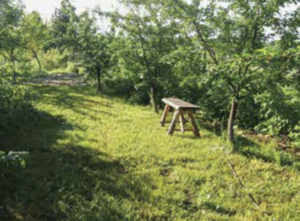The Seven Layers of A Forest Garden
A varied planting makes it harder for pests or diseases to find their object. A monoculture, such as an orchard planted exclusively with apple trees, is like an open invitation to insects to enjoy a sumptuous buffet of their favorite food or to disease organisms to spread unfettered. In contrast, a lone apple tree surrounded by a variety of other trees as well as shrubs, flowers, and ground covers presents many obstacles and distractions to apple pests, making it difficult for them to find and lay eggs on young apple fruits. Disease may spread more slowly and be less devastating. In sum, landscape diversity ensures health and resilience.
I’ve implemented the principle of maximizing diversity in my garden in several ways, including alternating species, planting mixed hedges and ground covers, and designing to maximize the edge effect.
I alternate species throughout my garden. As much as possible, I avoid placing two plants of a particular species side by side. For example, in a bed containing fruit trees, I included an apple, a cherry, a mulberry, a peach, and a persimmon, all surrounded by an array of other kinds of plants. There are exceptions to this rule. I do plant berry bushes such as honeyberries in a group for ease of U-pick harvesting.
In the United States, most traditional hedges or windbreaks are monocultures, such as a rose hedge or a cedar windbreak. Ground cover plantings tend to be single species, too—a big swath of pachysandra or periwinkle, for example. Whenever I design a hedge or windbreak, though, I make it as varied as possible.
I modeled my hedges in the Enchanted Edible Forest after the ancient hedgerows I observed in the rural parts of England where, I was told, you could guess the relative age of a hedgerow by the extent of diversity found in it. Over the long span of years, birds nesting in the dense greenery of a hedge excrete viable seeds of a wide range of plants. Some of those seeds germinate. It’s one of nature’s best planting methods, and it effectively increases a hedge’s diversity over time. The hedgerows in England contain tall trees, bushes, brambles, and many other species. Following that model, I designed my hedges and windbreaks to include a diversity of trees, bushes, brambles, and ground covers. Whenever I want to add a tree to my garden but can’t find a spot for it, my go-to solution is to plant it in a hedge.

A wide, grassy path allows early-morning light to bathe all the branches of the cherry trees on the right.
In some situations, a uniform ground cover is inevitable because one species is so dominant it displaces others in the area, or because only one type of plant is suited to a challenging habitat. But apart from such circumstances, diversity is also desirable in a planting of ground covers. In most locations, having two or more ground covers interplanted or bunched in groups by species contributes to the overall diversity of the garden.
The overall goal in designing a forest garden is to follow nature’s model. In nature the greatest diversity is often found at an edge where two habitats meet, such as where a meadow transitions into the woods. A riverbank or lakeshore is also a natural edge. In an edible forest garden, the intent is to mimic the diversity of plants found in a forest edge, possibly the most diverse habitat of all in a temperate climate. At the edge of a natural wood-land, there is abundant light, which encourages plant growth in many layers, from the treetops all the way down to the ground surface. This is quite different from the environment farther into the woods, where very little sun reaches the ground level and only shade-loving plants can survive. It’s possible to plan a forest garden to allow plenty of patches where ample light reaches the ground so that a wide variety of plants can grow even though the trees and shrubs will cast some shade.
